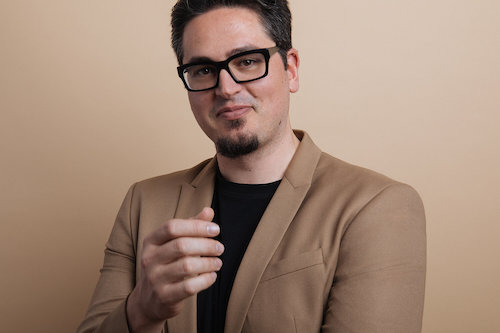by Mike Telin

Turrisi, himself an award-winning multi-instrumentalist, has been called a “musical alchemist” and a “musical polyglot.” In 1997 he left his native Italy to study jazz piano and early music at the Royal Conservatory of The Hague, where he obtained bachelor’s and master’s degrees. Since then he has released five albums as a leader and two as co-leader with the ensembles Tarab (which blends Irish and Mediterranean traditional music) and Zahr (which celebrates the connections between southern Italian traditional music and Arabic music).
Since Turrisi teamed up with Giddens in 2018, the duo has released two albums that combine Mediterranean music with music from the African diaspora in the Americas — There Is No Other (2019) and They’re Calling Me Home (2021), which won a Grammy for best folk album.
“We’re looking forward to the Oberlin concert,” Turrisi said during a recent telephone conversation. “We’ll play music from our two albums along with some folk material and classic songs of Rhiannon’s, so it will be a unique selection of pieces, you could say.” The two will be joined by bassist Jason Sypher, Giddens’ longtime touring collaborator.
When asked how he and Giddens first came together, Turrisi said he was happy to take the credit. “I reached out to Rhiannon a little bit out of the blue.” Although Turrisi was already living in Ireland and knew the music of Giddens’ group Carolina Chocolate Drops, he had no idea that she had a connection to the country until a friend went to one of their concerts and told him about a woman who sings, plays the banjo, and lives in Ireland.

As it turned out Giddens was receptive to the idea of collaborating. “So one afternoon we got together and I recorded the rehearsal.” Turrisi said that he loved the sound, but it was difficult to make their schedules line up. “It was to the point where I thought I should just give it up. But when the time was right we managed to get together and started the collaboration. And now we’re partners in life too. It was cosmic timing for everything.”
When asked why the partnership works so well, Turrisi laughed. “It’s interesting because on paper we don’t really fit together. I always joke that Rhiannon studied Italian opera at Oberlin and I studied American jazz in the Netherlands, but I’m the Italian and she’s the American, so that’s kind of a funny starting point.”
The pianist pointed out that they do share similar approaches to music. They both love jazz, although he never studied anything earlier than the 1940s, and her interest in it stops at the ‘30s. “Even with classical music, she’s really into Romantic opera and I studied Baroque music, but I stop at Mozart. So it’s funny, we have all these things in common but at the same time, not really — in theory there’s no overlapping territory. But all these musical languages rub shoulders with each other. So I think that’s why all these things work.”
One of the duo’s first sound discoveries was combining a minstrel banjo with a Mediterranean large frame drum. “They sound so good together — too good to have just been invented by us. Then you realize that the banjo is an instrument that developed in the African Diaspora, but its relatives in Africa connect it to a whole family of instruments that goes all the way to North Africa. And those instruments do play with a frame drum.”

The banjo was also central to the duo’s second meeting. “Rhiannon was showing me banjo tunes from these 19th-century minstrel books, and one tune had a rhythm that reminded me very much of a Southern Italian tarantella. So I picked up my tamburello, which is a Southern Italian tambourine, and started playing with some traditional Sicilian techniques.” Turrisi said that they made a video, and as soon as it was posted the comments started coming.
“One guy was a researcher and had a whole theory about the relationship of the tambourine to the minstrel band and its connection to Italy. We were mind-blown, because we were just making up stuff. And this guy — well, I could be here for seven hours telling you all that we discovered about the banjo and the tambourine. That’s why, especially in our first album, we have the tambourine, the tamburello, and the banjo — because they are closely connected in the history of 19th-century American music. But we’re both nerds — we like to read and we like to research — so it gets done.”
One unique instrument that is featured in They’re Calling Me Home is the cello banjo. “This is an instrument that I think Rhiannon bought from the collection of Mike Seeger when he died. His widow sold a few instruments to musicians that knew him and knew that they would be in good hands. But an original Gibson 1920s cello banjo is an incredible instrument.”
Turrisi explained that the instrument was developed at a time when banjos were “super popular” and were built in families. “This was almost like in the Renaissance when they made all the instruments in families so they could play four-part harmony. But the cello banjo has the range of a cello and a beautiful dark tone. When I picked it up it reminded me of a lute. On our latest record, if you listen to the Monteverdi “Si Dolce el Torrmento,” it’s just cello banjo and voice — if you don’t know what it is, it is hard to guess. I love the instrument so much and it connects to my early music side.”
Speaking of which, before we ended our conversation I needed to find out how Turrisi came to do a combined degree in jazz and early music. Again he noted that the two musics do rub shoulders. “The Hague Conservatory is one of two in Europe with the biggest early music departments. And when I was exposed to it I was fascinated that in early music there is a lot of improvisation. And the more I got into it, I realized that Baroque musicians — at the time — were more like jazz musicians. They improvised, they wrote their own music, so their skill set was so much closer to jazz than it is to classical nowadays. When I finished my BA, I applied for a combined master’s in jazz and early music. So I did research on improvisation, especially in late 16th-century, early 17th-century Italian keyboard music.”
Turrisi said that he approached the discipline with the mindset of a jazz improviser. “Many Baroque musicians come from Classical/Romantic training so they try to unlearn everything in order to approach early music in a fresher way. But coming from jazz I already had the mentality, so for me it was easy to learn the language.”
Returning to the question of why their partnership works, Turrisi said, “The reason we found each other is that we were both trying to do the same thing in different ways. I think for her it’s important that classical and folk musicians shouldn’t be separate the way that they are now. We don’t believe in genres — they were invented to sell records and separate people. Until the recording industry there were no genres, and we’re trying to promote that in the 21st century.”
Published on ClevelandClassical.com September 27, 2022.
Click here for a printable copy of this article



